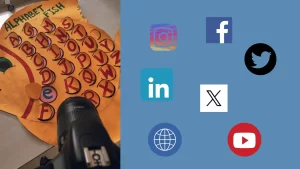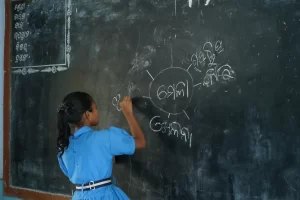Learning Revolution: YSD’s Project Sparks Change in Kids, Educators and Communities!
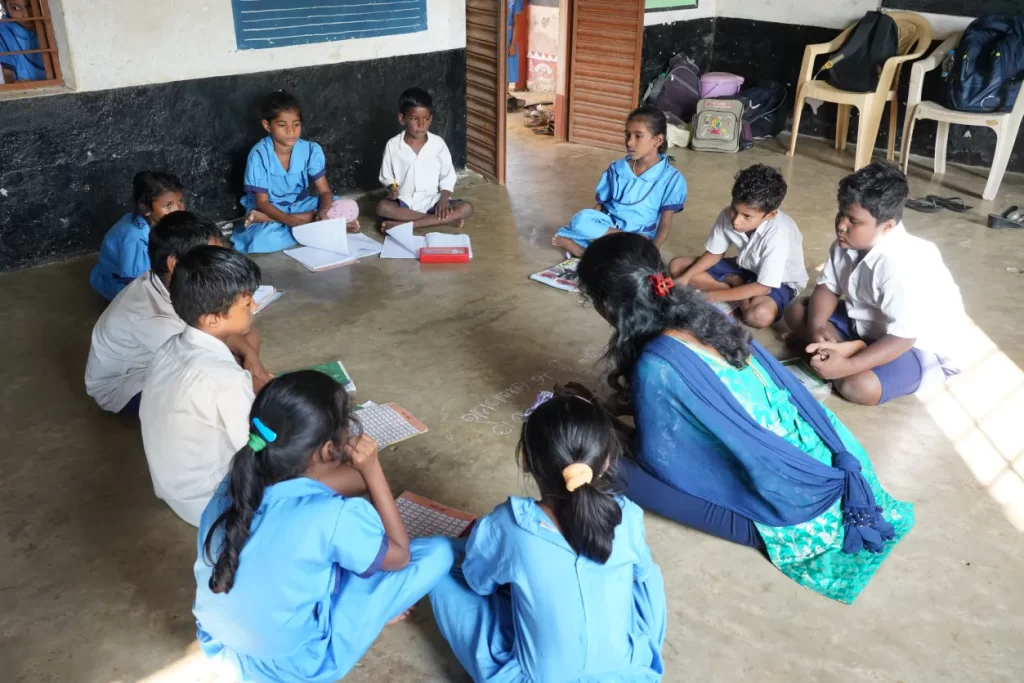
The covid pandemic across the country had a devastating impact on the learning levels of the children in the primary classes. The children lost out on the learning of Foundational Literacy and Numeracy (FLN) during the period. Therefore, it was imperative to bring these children up to the required level as quickly as possible. YSD launched its education initiative to impact these children in 2023.
- To improve the foundational learning (literacy and numeracy) of children in grades I-V in government schools in remote rural areas and slums
- To build and train a core team of educators and programme implementers to effectively design, manage and monitor the progress.
- To design an effective long term, scale up plan in the district based on the outcome by working closely with the government department.
What did YSD do?
The project consisted of several components.
- Sixty schools across the three blocks of Purusottampur (26), Khallikote (18), and Rangeilunda (16) of Ganjam district were targeted in the project. They were selected through a systematic process based on certain criteria; over 4000 odd children from these schools were also selected based on relevant criteria
- A core ‘education team’ of 14 was engaged and trained by the Pratham Foundation training team
- Learning levels of children were measured before the learning camps.
- Community Learning and Support Centres were set up for children who had dropped out or were of low leaning levels. Here, children who had dropped out or were irregular were taught to bring them up to their expected learning level and motivated to go back to school.
- Running of learning camps/bridge courses for children with lower learning levels at the school
- Teaching Learning Materials (TLM) provided by Pratham as well as some prepared by the educators themselves were used to conduct an hour-long class in a group for children of lower level of learning. While children of class 1 and 2 were only told stories and asked to play games in groups (while they learned basic concepts), children of class 3 to 5 were taught Odiya and Maths through group activities, use of charts and pictures as well as games, dance, songs, and stories.
- Learning levels were measured again after the bridge course and learning camps.
- School assessments were carried out for all 60 selected schools onset criteria.
What was the methodology followed for the evaluation of the project by the independent evaluator, Dr. Sita Sekhar?
The evaluation was carried out with a mix of Desk Review, Quantitative and Qualitative approaches.
The Desk review included the following materials:
- Training materials of Pratham
- Tools for measurement of learning level for Language and Mathematics
- Teaching-learning materials used by implementers during the camp
- CVs of YSD’s implementation team
- Project proposal
- Periodic reports of the project
- Management Information System data
Quantitative analysis included analysis of data collected during the project at baseline and end line. Data on school conditions has also been analysed. This data was on learning levels of children by location and class, before the implementation and after, distribution of students by gender and learning levels.
Qualitative analysis was done through Interviews with a sample of each of the 15 types of stakeholders to get an insight into qualitative aspects of the impact of the project. The stakeholders included: teachers, head teachers, education officials BEOs and CRCCs, children, parents, members of SMCs, PRI members, Pratham team YSD project team, and donor representatives.
What did the evaluation of the project conducted by Dr.Sita Sekhar find?
- The impact of the summer camp in villages, was evident as it generated excitement among children, parents, community members, and volunteers alike. Notably, there was a noticeable boost in confidence among both children and parents regarding the improvement of their learning skills. The closing exhibition on language, math, and science was a culmination of these efforts, and it attracted widespread participation and encouragement from various stakeholders. The success of the summer camp demonstrates the positive ripple effects on the community, fostering a sense of enthusiasm and confidence in the pursuit of enhanced educational outcomes.
- The Desk Review of the Teaching learning materials (TLM), proposal given by YSD to IDRF, note on community learning centres, periodic progress reports submitted, assessment materials provided by Pratham, notes on summer camps and CLSCs showed that the project implementation was highly efficient, and documentation of each stage was done well. The robust Pratham ASER tool for assessment and the acclaimed TLM provided by Pratham during the training of the YSD team were put to excellent use by the young team along with innovative TLM prepared by the team itself.
- The Ten Community Learning and Support Centres that were setup, did an excellent job of improving learning levels of most children who came there as well as helped send the dropout and irregular students to get back to school. Conversations with various stakeholders demonstrated that the learning centres were helpful in bringing children back to school as well as to improve their learning levels. The parents also understood the importance of education for their children and found the learning centres very influential and useful for their children. All stakeholders emphasized that the team members put in a lot of effort to motivate the children to join the classes and then once the children attended the classes and liked the teaching style, they became regular in the class and eventually at school.
Baseline and end line assessments with the ASER tool
The summary tables below present the numbers of children tested and targeted by level of learning and class during the baseline assessment.

For all tables note: level 0 for language is beginners, 1 is those who can read letters, 2 is those who can read words, 3 is those who can read paragraphs, and 4 is those who can read stories. For maths 0 who didn’t know any numbers, 1 is those who recognized numbers from 1 to 9, 2 is those who recognize numbers from 1 to 99, 3 is those who know subtraction, 4 those who know division.
Out of the 4033 students from classes 3 to 5 who were tested, 3272 were targeted for the project. Those who scored above 3 were not selected. Apart from the children from 3rd to 5th grade, 2784 children from 1st and 2nd grade were also involved in the process through games and learning activities.
Table 2 below gives distribution of targeted children by levels in language and maths and class

Once the camps were completed, the end-line learning level assessment was carried out. The results from the end-line testing are given in Table 3 below.

A comparison between baseline and end line results of tests showed a marked improvement in the learning levels of the children of all ages.
Marked improvement evident in Language assessment
The changes in levels of learning from the baseline to the end line assessment demonstrate the improvement in levels because of the intervention. Chart 2 depicts this significant improvement at the overall level. It can further be observed that the percentage of children in the first four levels has gone down between the baseline and the end line. This indicates that most children jumped from the lower levels right up to the highest level, where the level went up from 0 to 62% which is a substantial jump.
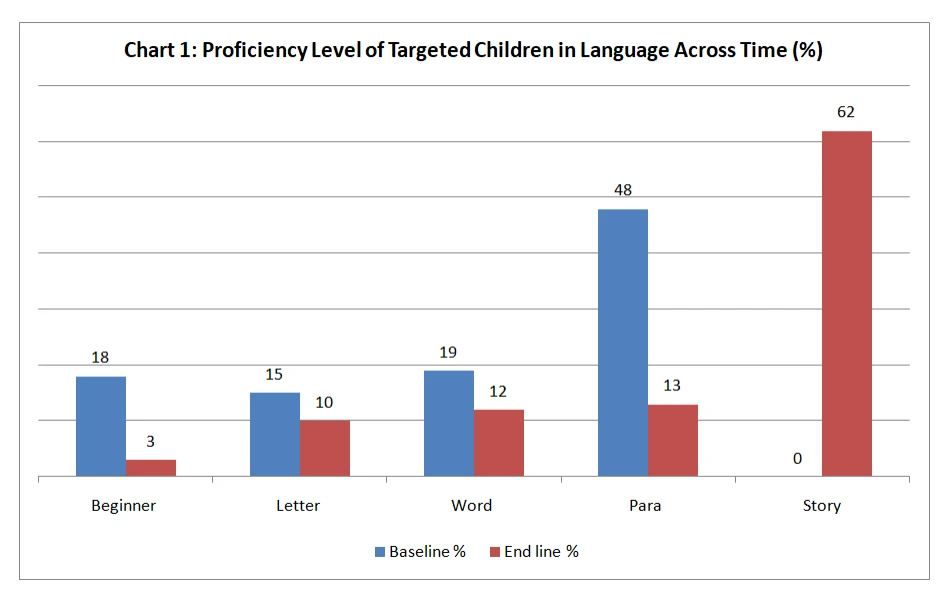
Dramatic improvements shown in Maths assessment
Chart 2 below clearly shows the dramatic changes that have occurred in the maths learning levels of children after the intervention. Even in Maths the same thing has occurred. Percentage of children in the first 3 levels has decreased by a reasonable level, while the percentage of children in the last two levels has gone up, with the percentage of children in the highest level of division going up significantly from 0 to 42.
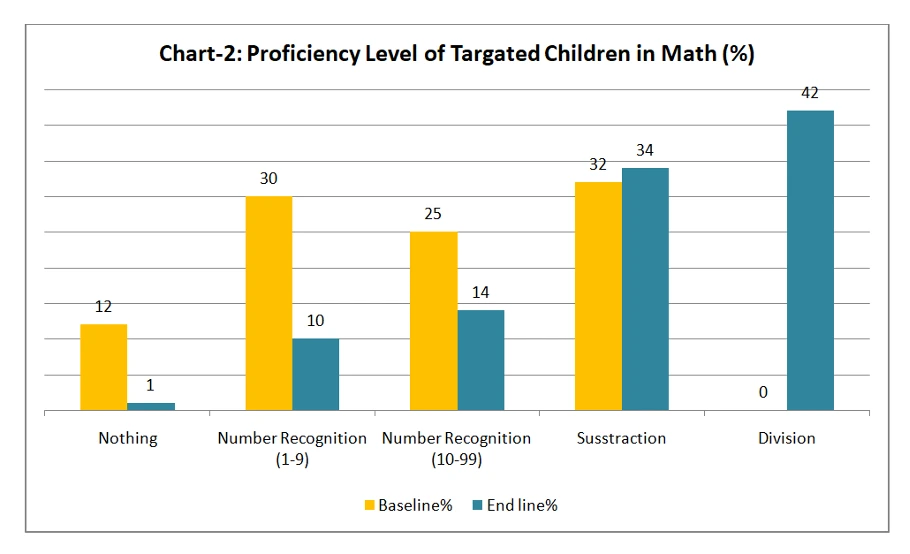
Snippets of interviews with stakeholders
The following snippets of interviews with all stakeholders will give an idea of their feedback on the project in their own words –
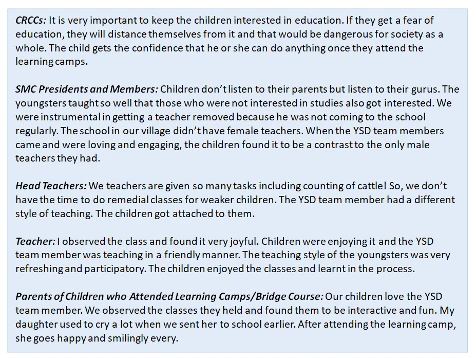
Conclusions
After the perusal of all the documents related to the project, analysis of the quantitative data collected and having interviewed a large sample of various stakeholders involved, triangulation from the three activities, the following conclusions emerged.
- The project is a huge success.
- Project design is comprehensive.
- Targeting is on point.
- There is a significant impact.
- The reach of the concept has been immense.
Overall, the gratitude of the community and other stakeholders and the smiles on the faces of the children are a mark of the impact of efforts made to reach the vulnerable sections whether it be in rural areas or urban areas. Illiterate parents whose aspirations lie in the education of their children but are underserved due to their circumstances or location were very satisfied with the project.
By Dr. Sita Sekhar
Governance Research Consultant
She has three decades of experience in developing, using and training on application of social accountability tools to various key development sectors.
PS : The views and opinions expressed here are those of the individual authors and do not reflect the views or positions of the organisation.

